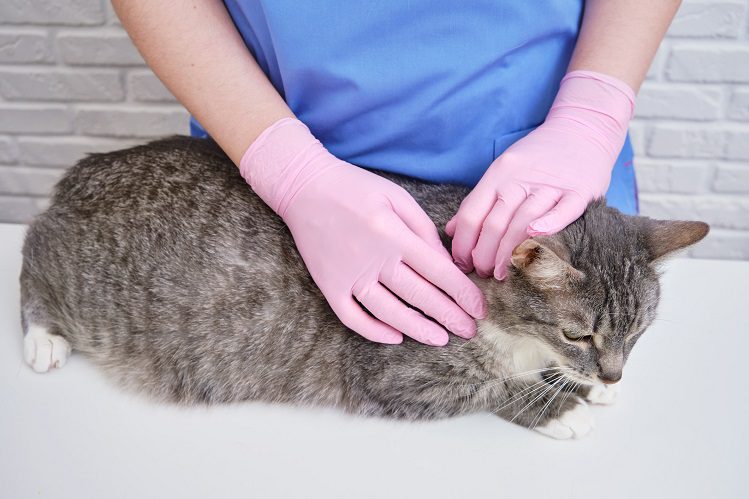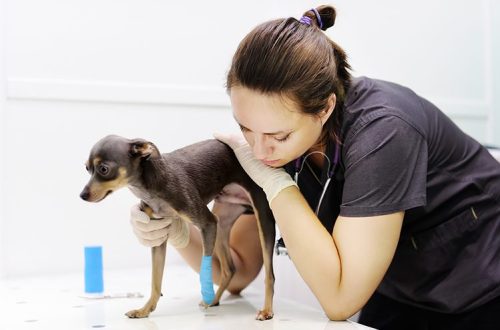
Flea dermatitis: what is it and how to treat it
Flea dermatitis is an inflammation of the skin caused by flea bites and an allergic reaction to their saliva. The severity of the disease does not depend on the number of parasites, since sometimes even a single bite can lead to an advanced stage of the disease.
The disease does not depend on the season in any way, but most often veterinarians note its mass character in summer and autumn, because. at this time, fleas are most active.
If there is no treatment for dermatitis or it is not enough, it threatens with complications.
Contents
Causes of the disease
Fleas are year-round parasites that can live and breed anywhere. The most dangerous fleas living in basements and porches of houses. From there, they easily get into apartments and pets: on their own through cracks in the walls or are brought in on clothes or shoes.
Here are the most common routes of infection:
- a pet can become infected in the entrance if it accidentally jumps out of the apartment;
- fleas can get into the apartment on the clothes and shoes of the owner;
- a dog can bring parasites into the house from the street after a walk;
- during a self-guided tour.
Even kittens that have never been outside are susceptible to flea dermatitis.
Who gets flea dermatitis?
Every pet can get sick with flea dermatitis. But most affected by it:
- animals with a tendency to allergic reactions,
- fragile kittens, because their immune system is not yet fully functional;
- weakened, sick pets;
- elderly pets,
- hairless dogs and cats.
Many pets practically do not react to flea bites, they can only occasionally itch. But if a quadruped has a predisposition to a negative reaction of the body to saliva and flea waste products, then the presence of these parasites becomes especially dangerous for him.
Flea saliva contains a component that prevents blood clotting. The toxin, being in the central bloodstream, causes an autoimmune disorder of the body as a whole. All this is accompanied by severe itching, which the animal tries to relieve: combs and licks the bite, thereby spreading the infection even more.
The severity of the disease does not depend on the number of fleas on the body. If a pet has an allergy, even a single flea bite will be enough for the body to respond.

How does flea dermatitis manifest itself and how to identify it?
Most often, flea dermatitis in cats and dogs is localized in the area of uXNUMXbuXNUMXbthe ears, on the withers, near the anus, on the inside of the thighs.
First you need to make sure that the animal has parasites. To do this, it is enough to carefully examine the tailed friend. You can put the pet on a white cloth or paper and comb it with a wet comb. On the wool or white coating, you will see the insects themselves or their droppings (red-black crumbs).
Flea dermatitis reveals itself almost immediately. The behavior of the pet changes, and the strongest scratches appear on its skin, up to baldness, ulcers, crusts, inflammation, swelling and redness. Moist areas form in the folds of the skin. The skin is hot to the touch. The coat becomes brittle and falls out, large areas of the skin become bald. The skin is very itchy and gives the pet the strongest anxiety. He may refuse to eat, be irritable.
The symptoms of flea dermatitis are similar to those of other skin diseases. Only a veterinarian can diagnose the problem.
Treatment of flea dermatitis
Treatment of a dog or cat from fleas should be carried out under the supervision of a veterinarian. The specialist will assess the extent of the spread of the allergic reaction, identify the number of parasites and, depending on this, prescribe a medicine and dosage. If you try to treat your pet yourself, you can use the wrong amount of the product, which will only make it worse.
Remember that if you suspect flea dermatitis, you need to act as soon as possible before the cat or dog has developed complications that are even more difficult to deal with.
There are a huge number of ways to treat dermatitis at home, but we strongly do not recommend resorting to them. Treatment of any disease should proceed only under the supervision of a specialist, especially such a disease that can lead to the death of the animal. You do not know for sure whether the chosen method of traditional medicine will help your pet or not. And if it does not help, you will only lose precious time and worsen the condition of your pet.

Prevention of flea dermatitis
We do not get tired of repeating – the disease is easier to prevent than to cure. Follow these rules to keep your four-legged friend healthy.
Treat your pet for fleas regularly. The room where the pet is located also needs to be processed. Clean the bed and wash the toys.
It is advisable to equip your pet with a flea collar, and bathe with flea shampoo.
It is good when a dog communicates with relatives on a walk, but communication with stray dogs can be dangerous. Avoid close contact between them.
Check your cat or dog regularly for fleas. Pay special attention to the abdomen and groin area, near the ears, the place at the withers.
Visit the veterinary clinic for a preventive examination at least once every six months.
Flea dermatitis is perfectly treated in the initial stages, if the pet has been provided with professional help. But your dog or cat will be allergic to flea bites for life, so it’s important to keep the parasites off their body. Use all available methods for this – then your beloved ponytail will be healthy and live a long and happy life.





